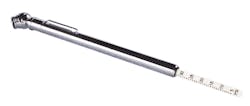This article was updated Feb. 14, 2023. It was originally published Dec. 11, 2014.
READ MORE: Hydrogen Pressure Sensors Must Withstand Extreme Pressures without Corrosion for Hydrogen-Powered Vehicles
Most engineers understand the concept of pressure. It’s a force, often measured in pounds, on a specific area. It is commonly listed in pounds per square inch (psi). But there are a variety of different types and units of pressure measurement. It is a good idea for engineers who deal in any way with pressure to understand the differences so that they know when to use specific measurements and units.
Types of Pressure
There are several types of pressure, and choosing the right one always depends on the application. Here’s a quick look at those different pressure types.
Absolute pressure defines its zero-point as the pressure of a perfect vacuum, which makes sense for some applications. Readings of absolute pressure include the pressure of the media plus the pressure of the atmosphere. Using an absolute pressure sensor eliminates any references to varying atmospheric pressure and relying on a specific pressure range for reference. Absolute pressures must be used in thermodynamic equations and relations.
Gauge pressure is the difference between a reference, most often local atmospheric pressure, and the gas or fluid in a container or hose. For example, a tire pressure gauge reads zero when merely held in your hand; it does not read or register the 15 psi of atmospheric pressure. But, connect it properly to the tire and it will reveal what the air pressure is inside the tire. Pressure sensors that use gauge pressure measure it in—typically seen in PSIG, BARG and kPaG.
READ MORE: 4 Conditions to Consider When Selecting a Pressure Sensor
Differential pressure can be a little more complex than gauge or absolute, but simply measures the difference between pressures in two medias. Most gauge pressures are differential pressure sensors, measuring the difference between the media’s and atmospheric pressure. True differential pressure sensors identify the difference between the two separate physical areas. For example, differential pressure is used to check pressure drops—or losses—from one side of an object to the other.
Sealed pressure is less common than the previous three but still has a place within the pressure world. It measures pressure referenced to a sample of atmospheric pressure hermetically sealed inside the transducer. When the sensor’s pressure port is exposed to the atmosphere, the transducer will indicate approximately 0 psi because there is a fixed atmospheric pressure on one side of the diaphragm and ambient atmospheric pressure on the other. If they are the same, the net output is 0 PSIS. If they are not the same, then the net output will be a reading other than 0 psi.
Internal pressure changes due to temperature create errors that exceed the sensor’s accuracy. That is why sealed sensors are used with high pressures where small error due to changes in the refence will not greatly affect the readings.
Units of Pressure
When measuring pressure, several units are commonly used. Most of them can be modified by using the international system of units’ conventions (e.g., micro, kilo and mega), even those they are not part of that measurement system.
Bar: One bar equals 100,000 Pascals, roughly the atmospheric pressure at sea level. More accurately, 1 bar is equivalent to atmospheric pressure at 112 meters at 15°C. The bar was defined in Europe and is common there. The word comes from the Greek word for weight (baros),which is also the root of the word barometer, a device that measures air pressure.
Inches of mercury (InHg): This units equals the force exerted by a one inch tall column of mercury one inch in diameter at one gravity and 0°C (32°F) which is almost 0.5 psi. InHg are typically used barometric pressure.
READ MORE: Flaws in Diamonds Become Pressure Sensors
Inches of water (InH2O): This unit is used to measure pressure, usually in low-pressure water applications. It equals the pressure of a one-inch tall column of water one inch in diameter at one gravity and 4°C (39.2°F) which is 0.04 psi. It is typically used for differential pressure measurement or in low pressure water applications.
Pascal (Pa): The Pascal is equivalent to one Newton of pressure per square meter, and one Pascal roughly equals 0.000156 psi. It was named after Blaise Pascal, a French mathematician and physicist. He conducted experiments and made advancements in hydrodynamics and hydrostatics.
Pounds per square inch (psi): This is the unit of measure for one pound of force applied to one square inch of area. It is the most common unit of pressure in the U.S.
Torr: This unit was named after Evangelista Torricelli, an Italian physicist and mathematician who discovered the principle of the barometer in the 1600s. He built a mercury (Hg) version and measured atmospheric pressure at 760 mm if Hg. So, the scientific community decided to make one millimeter of mercury, or 1/760th of an atmosphere, equal to one Torr in his honor. One Torr equals approximately 0.019 psi.
In many applications, absolute pressure is specified without any real need for it. There is a misconception that all pressure measurement needs to be absolute. While there is certainly a need for absolute pressure measurements, most applications only need gauge pressure or an alternative. By understanding the application details, selecting appropriate pressure sensor can be easy. A correct pressure sensor allows for more precise processes and for a proper outcome in the most efficient and economical way.
Kyle Horsman was a product specialist at Turck Inc.

